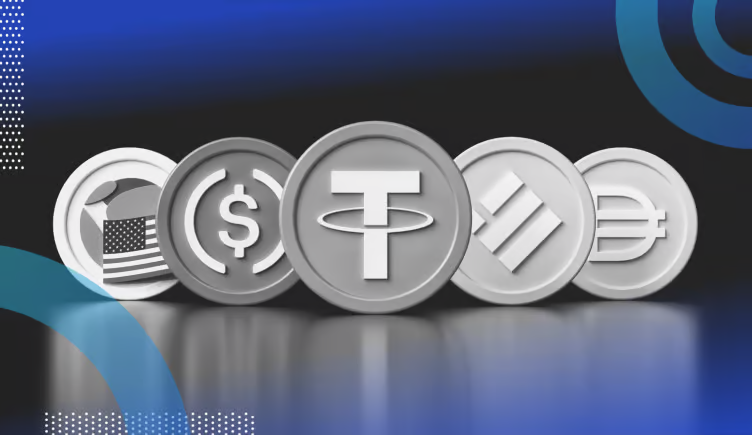
The unpredictability of cryptocurrency values makes it challenging to anticipate and depend on their worth over the medium or long term. Due to this lack of reliability, cryptocurrencies become less ideal for financial transactions necessitating a stable value over an extended duration, such as real estate transactions. Stablecoins were introduced to address this issue and contribute to the cryptocurrency market. Stablecoins are aimed to offer stability, enduring purchasing power, and the predictability characteristic of fiat currencies (for example, dollar, euro, and pound) while retaining the utility advantages associated with cryptocurrencies.
This week's educational guide outlines how stablecoins work, why they are important, and what can be expected in the future, given the current regulatory and financial climate in the crypto space.
What are Stablecoins?
Stablecoins represent a category of cryptocurrencies pegged to another asset class, ensuring a consistent and steady value. To bridge traditional fiat (i.e., dollar, euro, and pound) and digital currencies (i.e., Bitcoin, Ethereum, and Solana), stablecoins offer users the best of both. It provides the reliability and stability of fiat currencies and the efficiency, privacy, and decentralization of cryptocurrencies. This is particularly significant for users who prefer to avoid the extreme volatility of typical cryptocurrencies but still want to enjoy the benefits of a digital currency.
Initially, stablecoins were used by those deeply embedded in the cryptocurrency ecosystem. However, they have evolved into fundamental components of the digital currency landscape, reflecting the growing demand for more stable digital assets for everyday transactions and more complex financial operations.
Some of the most well-known stablecoins at the moment are:
- USDT (Tether)
- USDC (USD Coin)
- BUSD (Binance Coin)
Image Source: Shutterstock / BuiltIn Website
Technical Features of Stablecoins
Stablecoins can be classified into three types - fiat-collateralized, crypto-collateralized, and algorithmic stablecoins.
- Fiat-collateralized stablecoins are backed by a reserve of traditional currencies such as the US Dollar, Euro, or other government-issued currencies. For every stablecoin issued, an equivalent amount of fiat currency is held in reserve. Examples of this type include USDT (Tether), USDC (USD Coin), and PAX (Paxos Standard).
- Crypto-collateralized stablecoins are backed by other cryptocurrencies instead of fiat. These stablecoins use over-collateralization, holding more cryptocurrency than the stablecoin issued to absorb significant price fluctuations. A prominent example is Dai, which Ethereum backs.
- Any physical or digital assets do not back algorithmic stablecoins. Instead, they use algorithms to control the stablecoin supply, increasing or decreasing it to match demand and maintain a stable value. These stablecoins offer an entirely new approach to maintaining currency stability and are an exciting development area in cryptocurrency.
Use Cases
Stablecoins have found their niche in various applications due to their unique properties. They can be used for trading and hedging, providing a stable base currency for trading pairs on exchanges. They are also ideal for international money transfers, offering a faster, often cheaper, and more reliable alternative to traditional banking systems. The DeFi sector has embraced stablecoins for their stability and compatibility with blockchain technology. In this area, stablecoins are frequently used for earning interest through lending platforms, as collateral for borrowing, and as a stable medium of exchange for various financial instruments.
Regulation and Future of Stablecoins
Governments and financial authorities around the globe are currently debating stablecoins. As they are integrated into existing financial frameworks, issues like consumer protection, financial stability, anti-money laundering (AML) standards, and compliance with international monetary regulations must be addressed.
Image Source: Coinbase
Different regulatory frameworks across various countries have taken varied approaches to stablecoins. Some have welcomed them as innovative tools that enhance financial inclusion and efficiency, while others have expressed concerns about potential risks to the traditional financial system. To ensure their safety and avoid posing a systemic risk to users, the US is exploring ways to regulate stablecoins, while the European Union is working on a comprehensive framework for digital assets, including stablecoins.
Stablecoins could transform global payment systems, making transactions faster, cheaper, and more accessible, especially in underbanked regions. They could also play a crucial role in the evolution of digital commerce and the implementation of central bank digital currencies (CBDCs). As blockchain technology evolves and global financial markets adapt, stablecoins could offer a more efficient, secure, and stable solution for digital currency transactions.
Final Remarks
In summary, stablecoins are a crucial bridge between traditional finance and cryptocurrencies, offering a stable and efficient medium for transactions, savings, and investment in the digital age.
Technological advancements, market dynamics, and regulatory decisions will shape the development and adoption of stablecoins, making them a key area to watch in the evolving narrative of digital finance.





